brake Hyundai Elantra 2015 - RHD (UK. Australia) Manual Online
[x] Cancel search | Manufacturer: HYUNDAI, Model Year: 2015, Model line: Elantra, Model: Hyundai Elantra 2015Pages: 498, PDF Size: 9.45 MB
Page 424 of 498
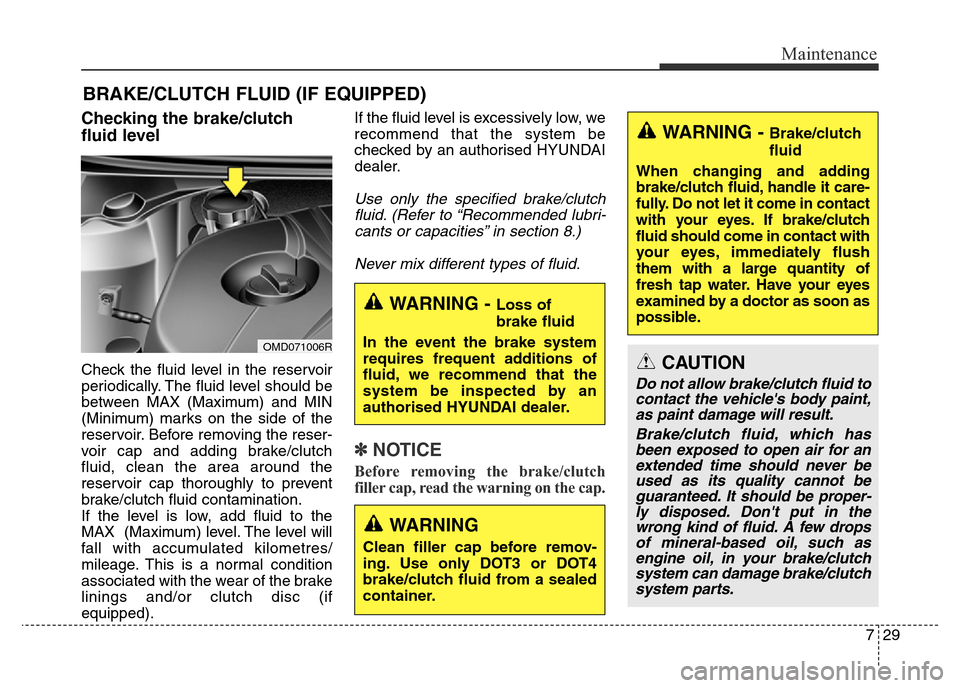
729
Maintenance
BRAKE/CLUTCH FLUID (IF EQUIPPED)
Checking the brake/clutch
fluid level
Check the fluid level in the reservoir
periodically. The fluid level should be
between MAX (Maximum) and MIN
(Minimum) marks on the side of the
reservoir. Before removing the reser-
voir cap and adding brake/clutch
fluid, clean the area around the
reservoir cap thoroughly to prevent
brake/clutch fluid contamination.
If the level is low, add fluid to the
MAX (Maximum) level. The level will
fall with accumulated kilometres/
mileage. This is a normal condition
associated with the wear of the brake
linings and/or clutch disc (if
equipped).If the fluid level is excessively low, we
recommend that the system be
checked by an authorised HYUNDAI
dealer.
Use only the specified brake/clutch
fluid. (Refer to “Recommended lubri-
cants or capacities” in section 8.)
Never mix different types of fluid.
✽NOTICE
Before removing the brake/clutch
filler cap, read the warning on the cap.
WARNING - Loss of
brake fluid
In the event the brake system
requires frequent additions of
fluid, we recommend that the
system be inspected by an
authorised HYUNDAI dealer.
WARNING - Brake/clutch
fluid
When changing and adding
brake/clutch fluid, handle it care-
fully. Do not let it come in contact
with your eyes. If brake/clutch
fluid should come in contact with
your eyes, immediately flush
them with a large quantity of
fresh tap water. Have your eyes
examined by a doctor as soon as
possible.
CAUTION
Do not allow brake/clutch fluid to
contact the vehicle's body paint,
as paint damage will result.
Brake/clutch fluid, which has
been exposed to open air for an
extended time should never be
used as its quality cannot be
guaranteed. It should be proper-
ly disposed. Don't put in the
wrong kind of fluid. A few drops
of mineral-based oil, such as
engine oil, in your brake/clutch
system can damage brake/clutch
system parts.
OMD071006R
WARNING
Clean filler cap before remov-
ing. Use only DOT3 or DOT4
brake/clutch fluid from a sealed
container.
Page 425 of 498
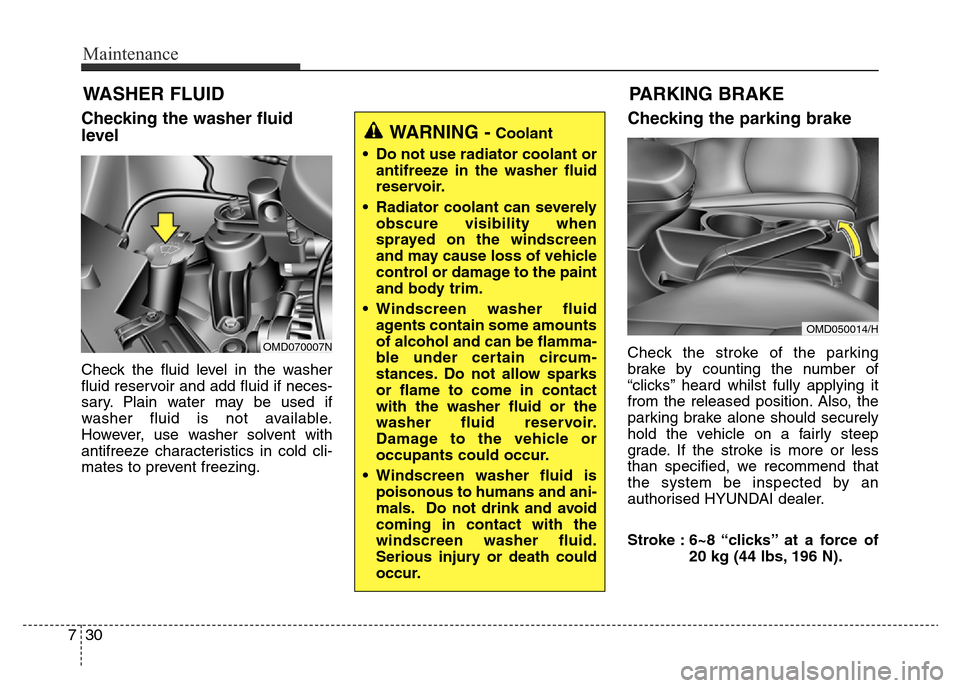
Maintenance
30 7
WASHER FLUID
Checking the washer fluid
level
Check the fluid level in the washer
fluid reservoir and add fluid if neces-
sary. Plain water may be used if
washer fluid is not available.
However, use washer solvent with
antifreeze characteristics in cold cli-
mates to prevent freezing.
Checking the parking brake
Check the stroke of the parking
brake by counting the number of
“clicks’’ heard whilst fully applying it
from the released position. Also, the
parking brake alone should securely
hold the vehicle on a fairly steep
grade. If the stroke is more or less
than specified, we recommend that
the system be inspected by an
authorised HYUNDAI dealer.
Stroke : 6~8 “clicks’’ at a force of
20 kg (44 lbs, 196 N).
PARKING BRAKE
WARNING -Coolant
• Do not use radiator coolant or
antifreeze in the washer fluid
reservoir.
• Radiator coolant can severely
obscure visibility when
sprayed on the windscreen
and may cause loss of vehicle
control or damage to the paint
and body trim.
• Windscreen washer fluid
agents contain some amounts
of alcohol and can be flamma-
ble under certain circum-
stances. Do not allow sparks
or flame to come in contact
with the washer fluid or the
washer fluid reservoir.
Damage to the vehicle or
occupants could occur.
• Windscreen washer fluid is
poisonous to humans and ani-
mals. Do not drink and avoid
coming in contact with the
windscreen washer fluid.
Serious injury or death could
occur.
OMD070007N
OMD050014/H
Page 439 of 498
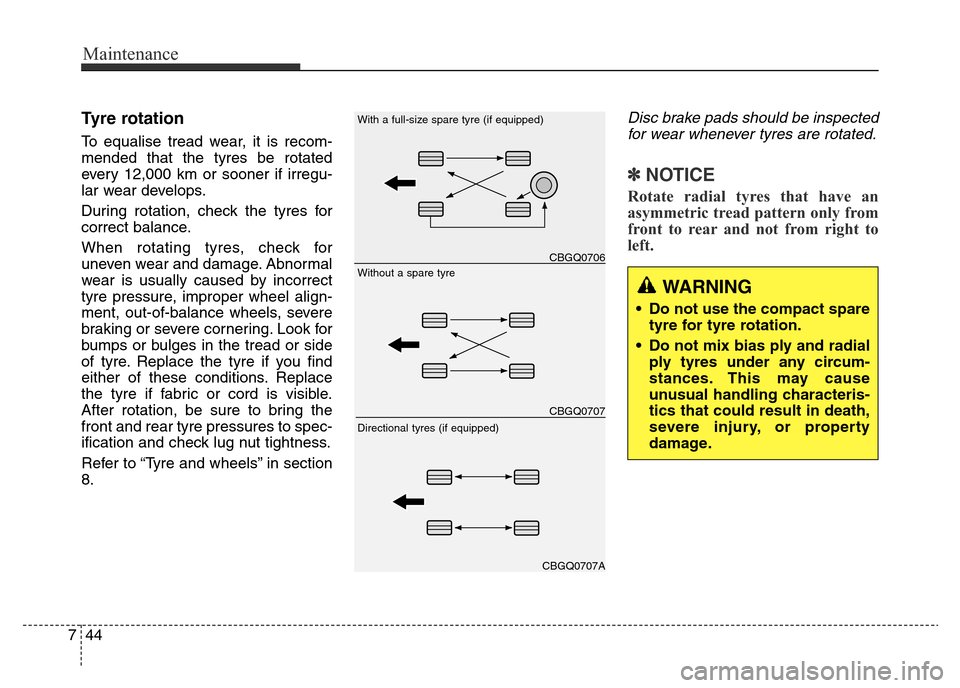
Maintenance
44 7
Tyre rotation
To equalise tread wear, it is recom-
mended that the tyres be rotated
every 12,000 km or sooner if irregu-
lar wear develops.
During rotation, check the tyres for
correct balance.
When rotating tyres, check for
uneven wear and damage. Abnormal
wear is usually caused by incorrect
tyre pressure, improper wheel align-
ment, out-of-balance wheels, severe
braking or severe cornering. Look for
bumps or bulges in the tread or side
of tyre. Replace the tyre if you find
either of these conditions. Replace
the tyre if fabric or cord is visible.
After rotation, be sure to bring the
front and rear tyre pressures to spec-
ification and check lug nut tightness.
Refer to “Tyre and wheels” in section
8.
Disc brake pads should be inspected
for wear whenever tyres are rotated.
✽NOTICE
Rotate radial tyres that have an
asymmetric tread pattern only from
front to rear and not from right to
left.
WARNING
• Do not use the compact spare
tyre for tyre rotation.
• Do not mix bias ply and radial
ply tyres under any circum-
stances. This may cause
unusual handling characteris-
tics that could result in death,
severe injury, or property
damage.
CBGQ0706
CBGQ0707
CBGQ0707A
Without a spare tyre With a full-size spare tyre (if equipped)
Directional tyres (if equipped)
Page 441 of 498
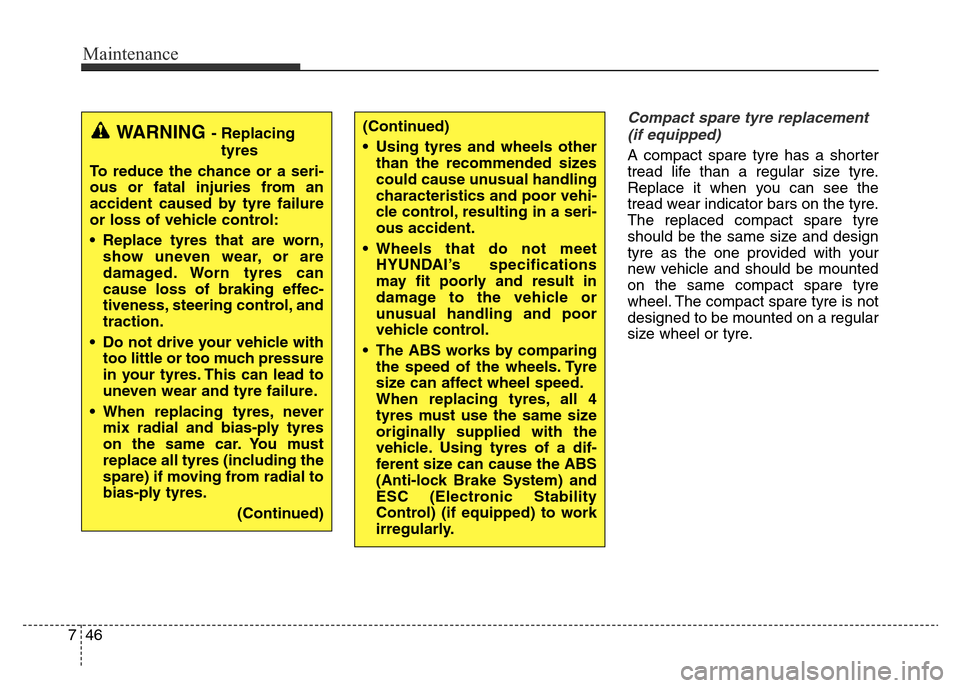
Maintenance
46 7
Compact spare tyre replacement
(if equipped)
A compact spare tyre has a shorter
tread life than a regular size tyre.
Replace it when you can see the
tread wear indicator bars on the tyre.
The replaced compact spare tyre
should be the same size and design
tyre as the one provided with your
new vehicle and should be mounted
on the same compact spare tyre
wheel. The compact spare tyre is not
designed to be mounted on a regular
size wheel or tyre.
(Continued)
• Using tyres and wheels other
than the recommended sizes
could cause unusual handling
characteristics and poor vehi-
cle control, resulting in a seri-
ous accident.
• Wheels that do not meet
HYUNDAI’s specifications
may fit poorly and result in
damage to the vehicle or
unusual handling and poor
vehicle control.
• The ABS works by comparing
the speed of the wheels. Tyre
size can affect wheel speed.
When replacing tyres, all 4
tyres must use the same size
originally supplied with the
vehicle. Using tyres of a dif-
ferent size can cause the ABS
(Anti-lock Brake System) and
ESC (Electronic Stability
Control) (if equipped) to work
irregularly.WARNING - Replacing
tyres
To reduce the chance or a seri-
ous or fatal injuries from an
accident caused by tyre failure
or loss of vehicle control:
• Replace tyres that are worn,
show uneven wear, or are
damaged. Worn tyres can
cause loss of braking effec-
tiveness, steering control, and
traction.
• Do not drive your vehicle with
too little or too much pressure
in your tyres. This can lead to
uneven wear and tyre failure.
• When replacing tyres, never
mix radial and bias-ply tyres
on the same car. You must
replace all tyres (including the
spare) if moving from radial to
bias-ply tyres.
(Continued)
Page 455 of 498
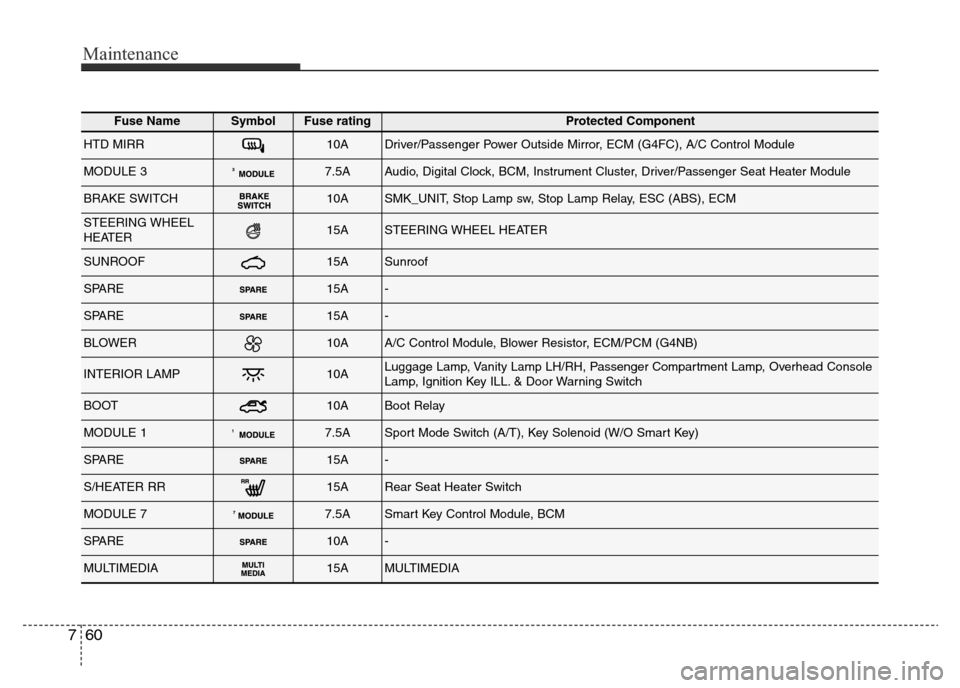
Maintenance
60 7
Fuse NameSymbolFuse ratingProtected Component
HTD MIRR10ADriver/Passenger Power Outside Mirror, ECM (G4FC), A/C Control Module
MODULE 37.5AAudio, Digital Clock, BCM, Instrument Cluster, Driver/Passenger Seat Heater Module
BRAKE SWITCH10ASMK_UNIT, Stop Lamp sw, Stop Lamp Relay, ESC (ABS), ECM
STEERING WHEEL
HEATER15ASTEERING WHEEL HEATER
SUNROOF15ASunroof
SPARE15A-
SPARE15A-
BLOWER10AA/C Control Module, Blower Resistor, ECM/PCM (G4NB)
INTERIOR LAMP10ALuggage Lamp, Vanity Lamp LH/RH, Passenger Compartment Lamp, Overhead Console
Lamp, Ignition Key ILL. & Door Warning Switch
BOOT10ABoot Relay
MODULE 17.5ASport Mode Switch (A/T), Key Solenoid (W/O Smart Key)
SPARE 15A-
S/HEATER RR15ARear Seat Heater Switch
MODULE 77.5ASmart Key Control Module, BCM
SPARE10A-
MULTIMEDIA15AMULTIMEDIA
Page 461 of 498
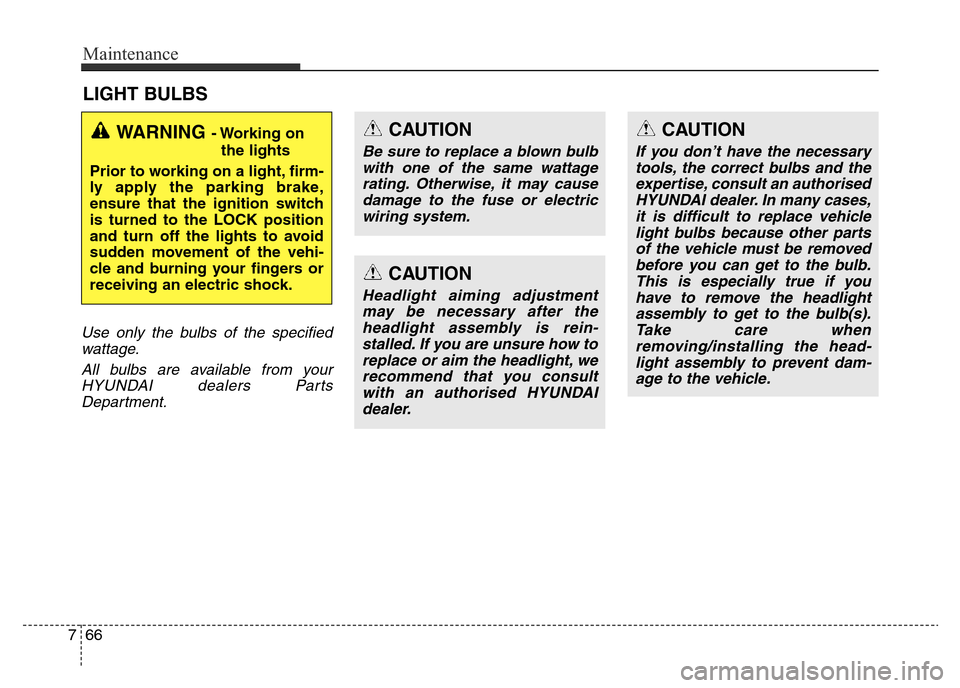
Maintenance
66 7
LIGHT BULBS
Use only the bulbs of the specified
wattage.
All bulbs are available from your
HYUNDAI dealers Parts
Department.
WARNING - Working on
the lights
Prior to working on a light, firm-
ly apply the parking brake,
ensure that the ignition switch
is turned to the LOCK position
and turn off the lights to avoid
sudden movement of the vehi-
cle and burning your fingers or
receiving an electric shock.CAUTION
Be sure to replace a blown bulb
with one of the same wattage
rating. Otherwise, it may cause
damage to the fuse or electric
wiring system.
CAUTION
Headlight aiming adjustment
may be necessary after the
headlight assembly is rein-
stalled. If you are unsure how to
replace or aim the headlight, we
recommend that you consult
with an authorised HYUNDAI
dealer.
CAUTION
If you don’t have the necessary
tools, the correct bulbs and the
expertise, consult an authorised
HYUNDAI dealer. In many cases,
it is difficult to replace vehicle
light bulbs because other parts
of the vehicle must be removed
before you can get to the bulb.
This is especially true if you
have to remove the headlight
assembly to get to the bulb(s).
Take care when
removing/installing the head-
light assembly to prevent dam-
age to the vehicle.
Page 479 of 498
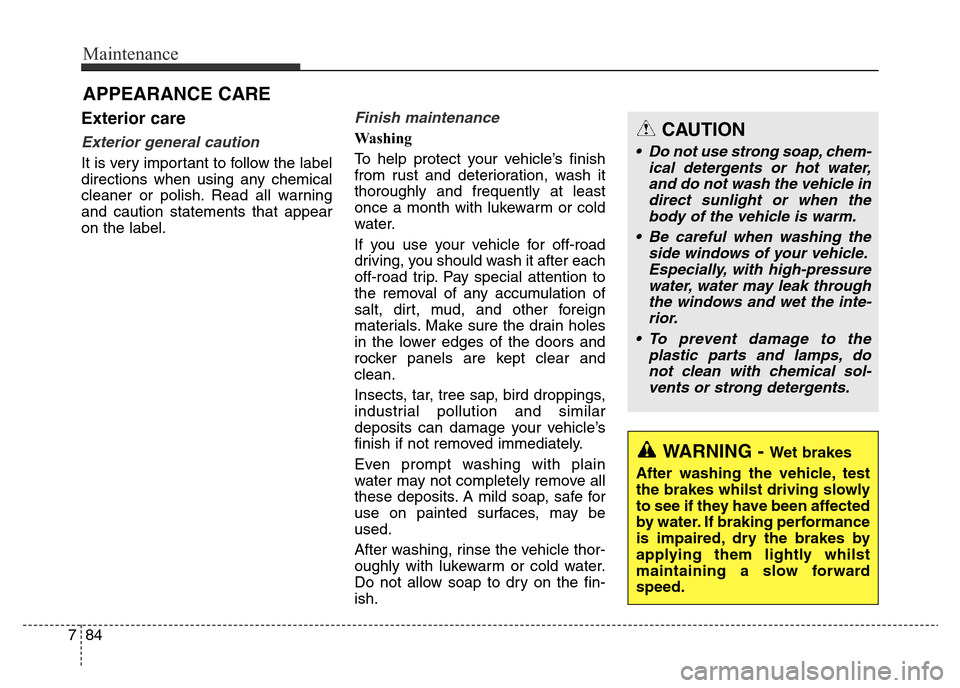
Maintenance
84 7
APPEARANCE CARE
Exterior care
Exterior general caution
It is very important to follow the label
directions when using any chemical
cleaner or polish. Read all warning
and caution statements that appear
on the label.
Finish maintenance
Washing
To help protect your vehicle’s finish
from rust and deterioration, wash it
thoroughly and frequently at least
once a month with lukewarm or cold
water.
If you use your vehicle for off-road
driving, you should wash it after each
off-road trip. Pay special attention to
the removal of any accumulation of
salt, dirt, mud, and other foreign
materials. Make sure the drain holes
in the lower edges of the doors and
rocker panels are kept clear and
clean.
Insects, tar, tree sap, bird droppings,
industrial pollution and similar
deposits can damage your vehicle’s
finish if not removed immediately.
Even prompt washing with plain
water may not completely remove all
these deposits. A mild soap, safe for
use on painted surfaces, may be
used.
After washing, rinse the vehicle thor-
oughly with lukewarm or cold water.
Do not allow soap to dry on the fin-
ish.
WARNING - Wet brakes
After washing the vehicle, test
the brakes whilst driving slowly
to see if they have been affected
by water. If braking performance
is impaired, dry the brakes by
applying them lightly whilst
maintaining a slow forward
speed.
CAUTION
• Do not use strong soap, chem-
ical detergents or hot water,
and do not wash the vehicle in
direct sunlight or when the
body of the vehicle is warm.
• Be careful when washing the
side windows of your vehicle.
Especially, with high-pressure
water, water may leak through
the windows and wet the inte-
rior.
• To prevent damage to the
plastic parts and lamps, do
not clean with chemical sol-
vents or strong detergents.
Page 481 of 498
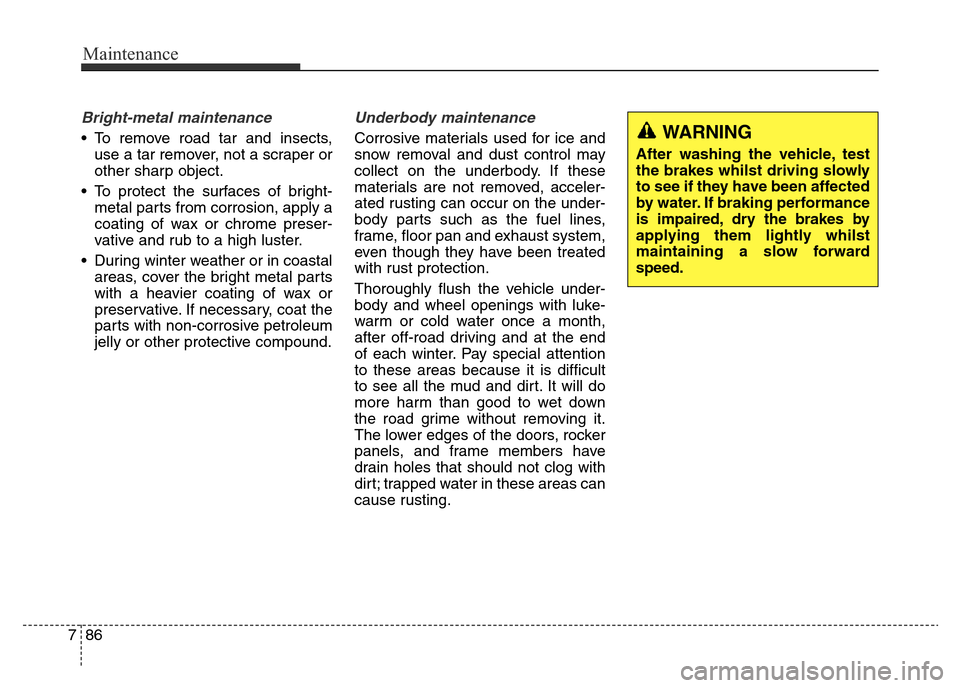
Maintenance
86 7
Bright-metal maintenance
• To remove road tar and insects,
use a tar remover, not a scraper or
other sharp object.
• To protect the surfaces of bright-
metal parts from corrosion, apply a
coating of wax or chrome preser-
vative and rub to a high luster.
• During winter weather or in coastal
areas, cover the bright metal parts
with a heavier coating of wax or
preservative. If necessary, coat the
parts with non-corrosive petroleum
jelly or other protective compound.
Underbody maintenance
Corrosive materials used for ice and
snow removal and dust control may
collect on the underbody. If these
materials are not removed, acceler-
ated rusting can occur on the under-
body parts such as the fuel lines,
frame, floor pan and exhaust system,
even though they have been treated
with rust protection.
Thoroughly flush the vehicle under-
body and wheel openings with luke-
warm or cold water once a month,
after off-road driving and at the end
of each winter. Pay special attention
to these areas because it is difficult
to see all the mud and dirt. It will do
more harm than good to wet down
the road grime without removing it.
The lower edges of the doors, rocker
panels, and frame members have
drain holes that should not clog with
dirt; trapped water in these areas can
cause rusting.WARNING
After washing the vehicle, test
the brakes whilst driving slowly
to see if they have been affected
by water. If braking performance
is impaired, dry the brakes by
applying them lightly whilst
maintaining a slow forward
speed.
Page 495 of 498
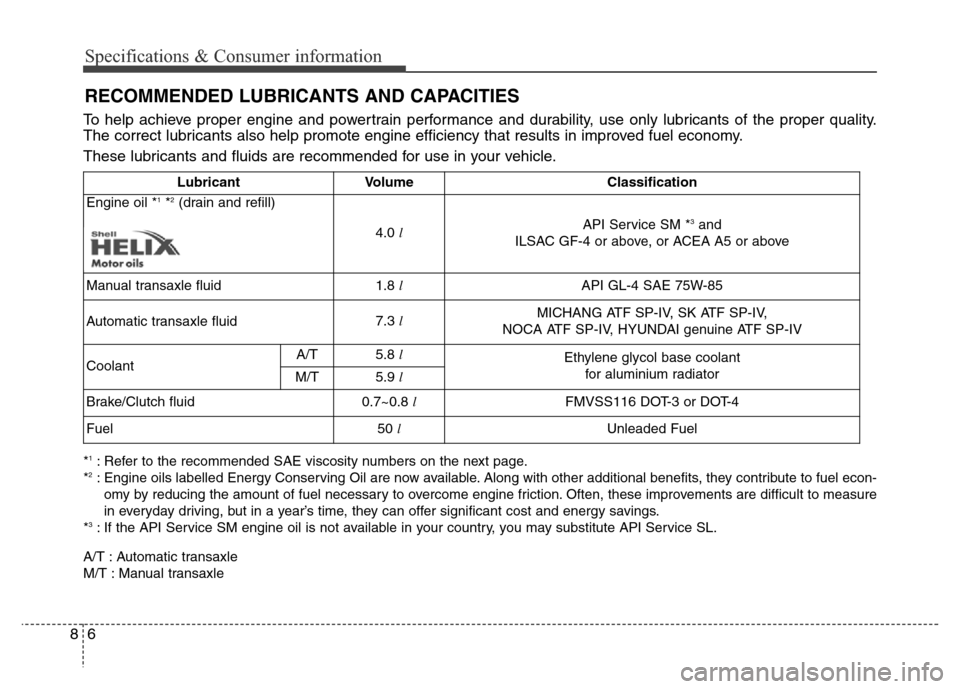
Specifications & Consumer information
6 8
RECOMMENDED LUBRICANTS AND CAPACITIES
*1: Refer to the recommended SAE viscosity numbers on the next page.
*2: Engine oils labelled Energy Conserving Oil are now available. Along with other additional benefits, they contribute to fuel econ-
omy by reducing the amount of fuel necessary to overcome engine friction. Often, these improvements are difficult to measure
in everyday driving, but in a year’s time, they can offer significant cost and energy savings.
*
3: If the API Service SM engine oil is not available in your country, you may substitute API Service SL.
A/T : Automatic transaxle
M/T : Manual transaxle
To help achieve proper engine and powertrain performance and durability, use only lubricants of the proper quality.
The correct lubricants also help promote engine efficiency that results in improved fuel economy.
These lubricants and fluids are recommended for use in your vehicle.
Lubricant Volume Classification
Engine oil *1*2(drain and refill)
4.0 lAPI Service SM *3and
ILSAC GF-4 or above, or ACEA A5 or above
Manual transaxle fluid1.8 l
API GL-4 SAE 75W-85
Automatic transaxle fluid7.3 lMICHANG ATF SP-IV, SK ATF SP-IV,
NOCA ATF SP-IV, HYUNDAI genuine ATF SP-IV
CoolantA/T5.8 l
Ethylene glycol base coolant
for aluminium radiator
M/T5.9 l
Brake/Clutch fluid0.7~0.8 l
FMVSS116 DOT-3 or DOT-4
Fuel50 l
Unleaded Fuel